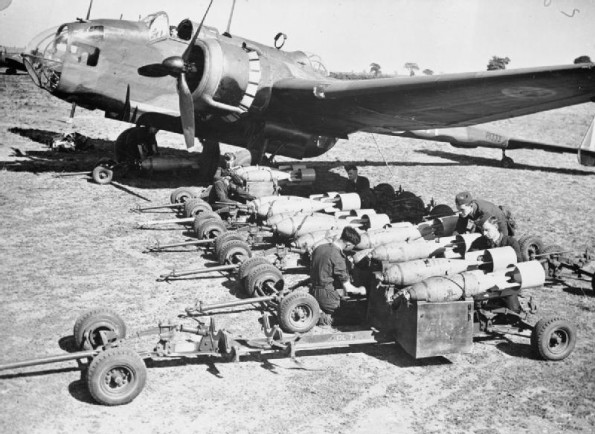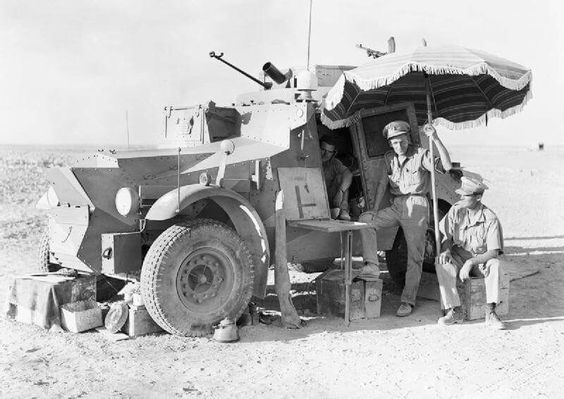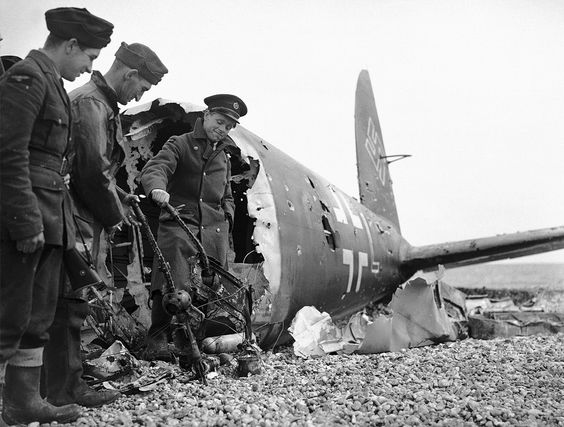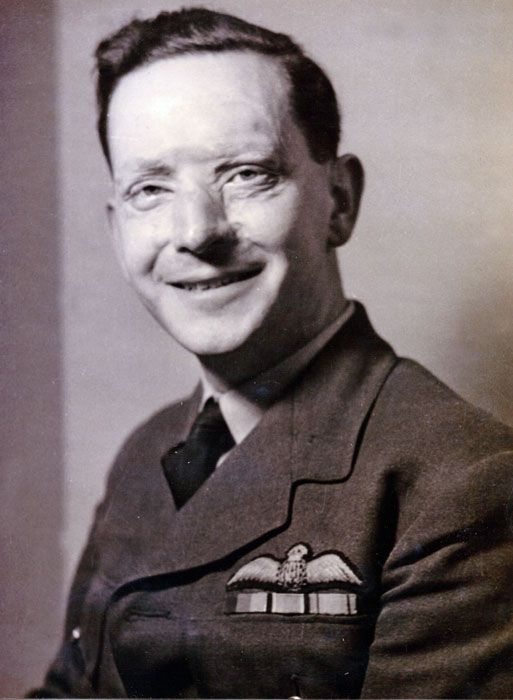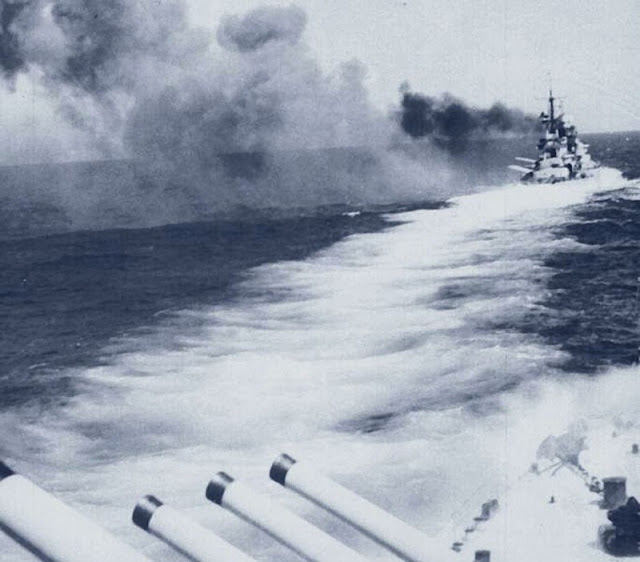Friday 13 December 1940
 |
| "A Wellington bomber crew studies a wall-mounted map, 13 December 1940." The man appears to be pointing at the Rotterdam area (© IWM (HU 104649)). |
The race is on between British and Italian formations to see who can get to the defensive positions on the border first. The Italians have a slight head start on the coast road, but the British 4th Armoured Division is cutting across the desert (just as the 7th Armoured Brigade did on the 12th) and hopes to outflank the Italians if they act quickly. Since it was never contemplated that the Italians would fold as quickly as they did, the British are hampered by lack of planning for this eventuality as well as troops strung out all across the desert. Many British resources are tied up handling the tens of thousands of Italian prisoners. Massive amounts of prisoners continue to be taken at Sidi Barrani and further west at Buq Buq.
In addition, the Italian Navy, probably the most effective of the nation's three major military services, begins to stir today. The Italians send submarines Naiade, Narvalo and Neghelli off the Libyan coast to counter the bombardment that Italian troops have been facing. Italian submarine Neghelli torpedoes and damages Royal Navy anti-aircraft cruiser HMS Coventry off the Libyan coast. The Coventry loses much of its bow area, forcing the ship to return to Alexandria in reverse in order to prevent further damage from the pressure of the seawater while the ship is underway. There are no casualties. Royal Navy submarine HMS Truant returns the favor by sinking Italian 1546 ton freighter Sebastino Bianchi northeast of Cap Spartivento.
The Italian Air Force also shows sudden vigor. The Regia Aeronautica CR 42 biplanes shoot down five Gloster Gladiator biplanes of RAAF No. 3 Squadron for only one loss of their own. RAF No. 274 Squadron also has a bad day, with the Italians shooting down two Hurricanes for a loss of only one CR 42. RAF No. 33 Squadron, however, evens the overall score by claiming victories over three CR 42s and two S79 bombers. Days like this show what the Italians would be capable of if they actually had their heart in the fight against Great Britain. The RAF also stages a raid against Tripoli Harbor, losing a plane from No. 830 Squadron.
British Prime Minister Winston Churchill sends a congratulatory telegram to commanding General Wavell, commander of British forces in the Middle East. Churchill has mixed feelings about Wavell, who he felt offered insufficient resistance to the Italians during the fall of British Somaliland over the summer. Thus, the telegram is restrained in its praise, with Churchill simply stating "Congratulations on your victory." Churchill also admonishes Wavell that he trusts "pursuit will hold first place in your thoughts" and "No doubt you have considered taking some harbor in Italian territory to which the Fleet van will bring all your stuff." One does not have to read too far between the lines of this faint praise to note the condescension being displayed, with Churchill's advice being akin to a coach telling his star soccer player, "Now, remember to kick the ball when it comes to you." Churchill obviously still feels that Wavell lacks the fighting spirit, even mere hours after Wavell has won perhaps the most decisive tactical victory of the century.
 |
| An electric street tram before it was destroyed by bombing at Abbey Lane in Sheffield during the night of 12/13 December (Sheffield City Council) |
The Greeks continue to grind forward, but the real action is back at Fuhrer Headquarters in Berlin. There, Hitler issues Fuhrer Directive No. 20, "Operation Marita." Operation Marita is a planned attack from Bulgaria into Greece:
to occupy the north coast of the Aegean and, should this be necessary, the entire mainland of GreeceThis Marita attack is tentatively scheduled for March, should the weather turn favorable by then - a highly doubtful prospect in that region. Hitler also drastically upgrades the force allocated to this operation. During the initial planning stages, OKH (Army High Command) Chief of Staff General Halder had felt that only a handful of divisions would be necessary to occupy northern Greece. However, Hitler now directs that 24 divisions will be involved, all of them to "join the military mission" as a pretext. Hitler knows full well, from Soviet Foreign Minister Molotov's 25 November 1940 proposed agreements for a New World Order, that the Soviet Union considers Bulgaria to be within its sphere of influence, which is one reason why he has not yet responded to that letter (and never will).
The German Army certainly has the troops to spare, but such a large force heading in the opposite direction must inevitably affect the forces available for his subsequent, and much more significant, operation - Operation Barbarossa, the planned invasion of the Soviet Union in mid-1941.
While the Germans are creating messes for themselves with all these planned invasions, Mussolini certainly would breathe a sigh of relief if he knew about this directive (and he won't, for the time being). Hitler is on the way to eviscerate the Greeks from behind while the Italian troops in Albania continue to suck in all the Greek reserves like flypaper grabbing all the flies that land on it. All the Italians have to do now is hold out until the spring, but this looks quite uncertain at the moment. It must be said, though, that rescuing Mussolini is only a secondary objective, as Hitler's overriding preoccupation is the removal of RAF planes from the Greek mainland. These planes threaten the Romanian oilfields, which inform many of Hitler's decisions in the region.
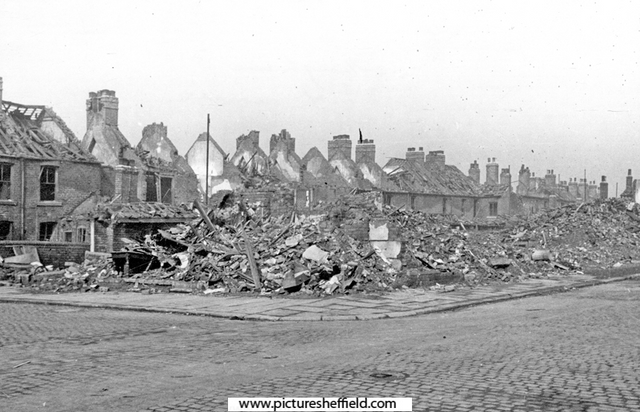 |
| Damage in Sheffield, 13 December 1940 (Sheffield Archives and Local Studies). |
Douglas Bader receives the Distinguished Flying Cross.
Battle of the Atlantic: U-43 (Kptlt. Wolfgang Lüth), toward the end of a lengthy patrol, spots 10,350-ton British freighter/passenger ship Orari about 830 km southwest of Ireland. It sends two torpedoes at the Orari, one of which hits it in the stern. Lüth is now out of torpedoes and the seas are too rough to provide a stable gun platform, so he has to watch as the Orari's crew plugs the hole with a tarpaulin and continues on its way to the Clyde. U-43 then heads back to Lorient.
German 842 ton freighter Schwalbe runs aground off Utö, Finland and is lost.
The 18,673-ton Norwegian liner Oslofjord has been beached on the Tyne after hitting a German acoustic mine on 1 December 1940. Since then, some of the crew have volunteered to stay aboard and salvage whatever they can. They have taken off thousands of pounds of mail and other cargo, but have been unable to save the ship. Today, after the crew finally abandoned it, the ship breaks up in the rough weather and is lost. The Oslofjord remains the largest shipwreck on the East coast of England, with its bow visible and pointing seaward. The area is popular with divers, and the ship itself has proven to be a hazard to navigation at times.
Royal Navy destroyer HMS Forester seizes Vichy French 780-ton trawler Avant Garde and takes it to Gibraltar.
The Luftwaffe strafes shipping in the Tyne, hitting destroyer HMS Maori. However, the damage is insubstantial and the Maori remains in service.
The Luftwaffe also lays more mines in the Thames Estuary.
Convoy FS 360 departs from Methil.
to move this force across Bulgaria to occupy the north coast of the Aegean and, should this be necessary, the entire mainland of GreeceThe most interesting aspect to Fuhrer Directive No. 20 in hindsight is the cursory mention of Yugoslavia. It only takes up one sentence in the entire directive, to wit:
The attitude of Yugoslavia is also not yet clearly foreseeable.By its placement in the directive after a similar statement about the Bulgarian military, Hitler seems to imply that there is a chance that the Yugoslavian army will be fighting with him rather than against him. To date, however, the Yugoslavian government has been steadfast in its unwillingness to commit to any alliances with Germany, though the "Eternal Treaty of Friendship" between Yugoslavia and Hungary signed the day before seems to have given Hitler some hope in that regard.
British Military: Fire Station Officer William Mosedale receives the George Cross for rescuing eight people trapped beneath his fire station and a nearby house. Captain Michael Floud Blaney of the Royal Engineers also wins the George Cross - posthumously - after he was killed by a bomb he was trying to defuse in Manor Park.
Vichy France: Marshal Pétain abruptly dismisses Pierre Laval, his Vice Premier and Foreign Minister. Pétain does it quite cleverly, convening a meeting of his cabinet ministers and requiring them all to sign a collective letter of resignation. Laval, believing he was in no peril, blithely signed along with the others, and then Pétain announced that he was accepting Laval's resignation (and also that of Minister of Labor M. Belin). Not only that, but Pétain has the police arrest Laval and places him under house arrest. Pétain's issue with Laval appears to have been personal, with Laval acting casually in Pétain's presence and even occasionally (so it is said) blowing cigaret smoke in his face. Pétain now views himself as an unassailable dictator on a par with Hitler, and in fact, many others would view that as an apt comparison.
 |
| The A-17A Nomad lost on 13 December 1940 was recovered in October 2014. (MIKE OLIVIERA / THE CANADIAN PRESS) |
British Homefront: The Duke of Windsor (former King Edward VIII) gives a disturbing interview to Fulton Oursler of Liberty magazine at Government House, Nassau, Bahamas. While not published until 22 March 1941, it raises eyebrows on both sides of the conflict. The Duke states that "Hitler was the right and logical leader of the German people," and proposes that President Roosevelt mediate a peace deal between Germany and Great Britain. Oursler is flabbergasted and arranges an appointment to discuss the interview with President Roosevelt at the White House. Rumors swirl that Wallis Simpson, the Duchess of Windsor, has had an intimate relationship with German Foreign Minister Ribbentrop (in the 1930s) and still communicates with him.
 |
| Australian freighter/passenger liner Orungal on fire, 13 December 1940. The Orungal ran aground during a storm on 20 November 1940 at Formby Reef outside Port Phillip, Victoria. The ship remained intact - in fact, the passengers slept aboard through the night without care before being taken off - and was scheduled to be refloated on 15 December 1940 when it suddenly caught fire in the boiler room at 02:30 on the 13th. The ship was a total loss. The boilers can still be seen at Barwon Bluff Marine Sanctuary during low tide. (Barwon Bluff Marine Sanctuary). |
December 1940
December 1, 1940: Wiking Division Forms
December 2, 1940: Convoy HX 90 Destruction
December 3, 1940: Greeks Advancing
December 4, 1940: Italian Command Shakeup
December 5, 1940: Thor Strikes Hard
December 6, 1940: Hitler's Cousin Gassed
December 7, 1940: Storms At Sea
December 8, 1940: Freighter Idarwald Seized
December 9, 1940: Operation Compass Begins
December 10, 1940: Operation Attila Planned
December 11, 1940: Rhein Wrecked
December 12, 1940: Operation Fritz
December 13, 1940: Operation Marita Planned
December 14, 1940: Plutonium Discovered
December 15, 1940: Napoleon II Returns
December 16, 1940: Operation Abigail Rachel
December 17, 1940: Garden Hoses and War
December 18, 1940: Barbarossa Directive
December 19, 1940: Risto Ryti Takes Over
December 20, 1940: Liverpool Blitz, Captain America
December 21, 1940: Moral Aggression
December 22, 1940: Manchester Blitz
December 23, 1940: Hitler at Cap Gris Nez
December 24, 1940: Hitler at Abbeville
December 25, 1940: Hipper's Great Escape
December 26, 1940: Scheer's Happy Rendezvous
December 27, 1940: Komet Shells Nauru
December 28, 1940: Sorge Spills
December 29, 1940: Arsenal of Democracy
December 30, 1940: London Devastated
December 31 1940: Roosevelt's Decent Proposal
2020

